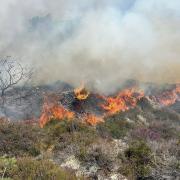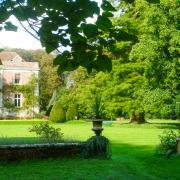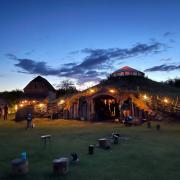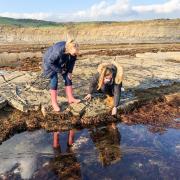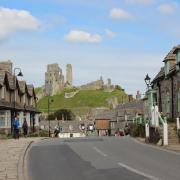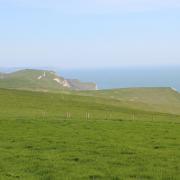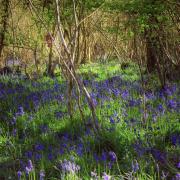Flower-rich grasslands are a characteristic feature of the Dorset Area of Outstanding Natural Beauty. Tom Munro reveals the healing power of this increasingly rare habitat and how new meadows are being planted across the Dorset landscape.
Dorset’s wildflower meadows
High-quality, flower-rich grasslands are a characteristic feature of the Dorset Area of Outstanding Natural Beauty (AONB). Only about a tenth of its semi-natural grasslands present in the early 1900s remain, much was lost to agricultural intensification. Fortunately, there are some key areas where this habitat persists. The terrain where wildflowers flourish in the Dorset AONB tend to be on the steeper ground that has avoided being ploughed in modern times (such as the sides of chalk valleys at Cerne and Sydling), wet ground that might swallow a tractor (the wet clay of the Marshwood Vale), or in areas where agricultural intensification simply wasn’t worthwhile or cost effective (around the Purbeck Heaths).

Best time of year
Head out to a wildflower meadow in June and July. Some of the more common flower species you will see are the white and yellow ox-eye daisies and the thistle-like flowers of knapweeds. Keep your eyes open for orchids and the white umbels of the marvellously named corky-fruited water dropwort found in damp meadows. Our top Dorset meadows to immerse yourself in are: Kingcombe National Nature Reserve (near Maiden Newton), Durlston Country Park (near Swanage), Stonebarrow and Hogchester (both near Charmouth) and Giant Hill (Cerne Abbas). For more information about all these sites including how to get there and what to see, visit the Dorset AONB Explore map.
dorsetaonb.org.uk/explore/map/

Bursting with life
An abundance of wildflowers means an abundance of food sources for other wildlife, supporting a richness of animal life great and small. Meadows are alive with the buzz of bees and other pollinators, visiting flowers to collect nectar and distributing pollen as they travel. Dozens of species of spider, beetle and grasshopper enjoy life among the grass and flower stems, and several types of butterflies are grassland specialists with many relying on one or two specific food plants. These are all food for birds and small mammals – swallows love swooping over these insect-rich fields, for instance, and barn owls are adept at locating mice and voles in the long grass.
Going underground
Thriving life above ground indicates a corresponding richness of life below ground. The roots of different types of plant occupy different zones in the soil; the more diverse the grassland, the more the soil is filled with living roots. These bring sugars and other products of photosynthesis into the soil which feed fungi; in return these fungi make nutrients available to the plants that they would not absorb by themselves. The soil is also home to earthworms and other burrowing animals and a wide range of microbes. Did you know, there are more living things in one teaspoon of soil than there are people on the planet?

Curious collaborations
Wildflower grasslands provide the habitat for some amazing interspecies relationships such as the Adonis blue butterfly which relies on horseshoe vetch and meadow ants to complete its lifecycle. The butterflies lay their eggs on horseshoe vetch which provides foods for its caterpillars. These caterpillars befriend ants by feeding them on a sugary secretion. By the time the caterpillar turns into a chrysalis, those ants take them to their underground nests, providing protection from predators. Three weeks later the butterfly emerges, these can be seen in late May to early July, with a second flush in August/September. Adonis blue sites are on the chalk downland of Purbeck, west and north Dorset.
Animal health clinic
Farmers often notice that livestock that feed on land rich in wildflowers need less help from the vet, particularly for minor ailments and parasites. Many wildflowers are known for their curative properties for specific ailments and used by herbalists for centuries. Livestock appear to be able to instinctively identify these properties too - a phenomenon known as zoopharmacognosy. Bird’s-foot trefoil and yarrow include plant chemicals known as flavenoids and alkeloids which reduce the impact of worms in cattle and sheep, thus reducing reliance on potentially environmentally harmful worming medicines. Also, as with humans, a more diverse diet for grazing animals is healthier for them than simply grass alone.

Meadows of wellbeing
Connecting with nature’s beauty helps to reduce stress and depression and boost your mood. Where better to seek this than in a wildflower meadow? For centuries our ancestors have been drawn to nature – so it’s not surprising to discover that the 12,000 generations of humankind had lives much more entwined with nature than ours. What is particularly interesting is that there is a growing body of evidence to suggest that microbes you pick up from the environment have a positive impact on your health and wellbeing. Many microbes that are specialists of healthy ecosystems have deeply beneficial effects when they colonise us – so get amongst the wildflowers and breathe deeply!
Climate changers
Wildflower grasslands are often very good at storing carbon, locking it up in the soil and helping mitigate global warming. These permanent, flower-rich grasslands should never be ploughed up – to do so would release all that carbon into the atmosphere. Undisturbed soils, particularly below a diversity of above-ground plant life, are a very safe place to store carbon – more so than above ground in trees, for example. In addition, these soils and the rough, raucous plant life above help absorb and hold rainwater, rather like a big sponge. This in turn can ease peak river flows and downstream flooding during wet periods by soaking it all up.

Meadow restoration
We have lost a huge areas of wildflower meadows, but we can bring them back. The Hogchester Meadows Expansion Project, near Charmouth, wanted to increase the availability of local wildflower seed for meadow restoration projects in the area. Conventional seed harvesting equipment was too bulky to access the small remnants of meadow left. So, with support from the Farming in Protected Landscapes programme and the Landscape Enhancement Initiative, a bespoke brush seed harvester was purchased, and training provided to operate it in a not-for-profit venture. With the help of volunteers to winnow and sort the seed, over 12 hectares of new meadows were seeded in 2022 at 18 individual sites.

Pretty as a picture
Our Take a Dorset View photography competition, run in conjunction with Dorset Magazine, is open for entries. We would love to see your photos of Dorset meadows. This lovely picture of a common scabious at Frampton by Lulu Fountain was an entry in our Youth Category in the 2020 photo competition. It brilliantly captured the very essence of flowers in the wild. The great thing about taking photos of wildflowers is that you don’t need a fancy camera – your smartphone will do an amazing job, especially in macro or portrait mode, wait for the light and wind to settle - and maybe a bee or butterfly too.




